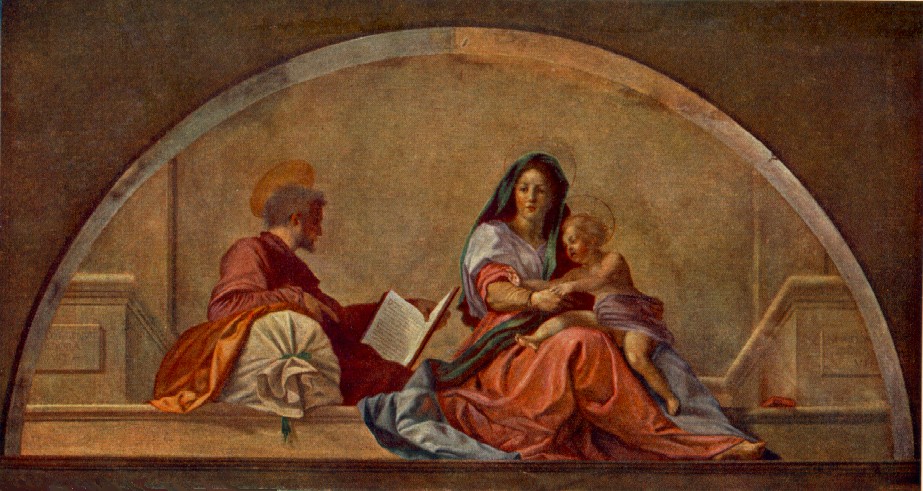His father was a tailor and, as was custom in many cases during the Renaissance, he took his father’s labor as his name: Andrea del Sarto – Andrea of the tailor. Enormous talent built a phenomenal career for a man who died at the young age of 43, a victim of the plague.
He was born in Florence.
In 1520 he resumed work in Florence, and executed Faith and Charity in the cloister of the Scalzo.

Charity – Del Sarto

Faith – Del Sarto
These were succeeded by the Dance of the Daughter of Herodotus, a series of frescoes which included the Capture of St. John the Baptist, the Presentation of the Baptist’s Head to Herod, an Allegory of Hope, the Apparition of the Angel to Zacharias (1523), and the monochrome Visitation.

Visitation – Del Sarto, 1524
This last was painted in the autumn of 1524, after Andrea had returned from Luco in Mugello, north of the Arno valley, where an outbreak of the plague in Florence had driven him and his family.
In 1525 he returned to paint in the Annunziata cloister the Madonna del Sacco, a lunette so named because Joseph is leaning against a sack of wheat. This painting is one of the first movements in Del Sarto’s work which is credited for influencing the work of one of Del Sarto’s pupils, Pontormo.

Madonna del Sacco, 1525
In 1523 Andrea painted a copy of the portrait group of Pope Leo X by Raphael. (Andrea’s copy is now in the Naples Museum, while the original remains at the Pitti.) The Raphael painting was owned by Ottaviano de’ Medici and commissioned by Federico II Gonzaga, Duke of Mantua.
Unwilling to part with the original, Ottaviano retained Andrea to produce a copy, which he passed to the Duke as the original. So faithful was the imitation that even Giulio Romano who had himself manipulated the original to some extent, was completely fooled. Years later he showed the copy to Vasari, who suspected the truth. It was only when Andrea showed Vasari the private mark on the canvas that all was revealed.
Leo X Group Portrait and Mantua
Among his many originals, it is also known that del Sarto created copies of some of his masterworks, and masterworks of other artists as well. One in particular is surrounded with an air of scandal and was a group portrait of Pope Leo X by Raphael. It is said that this painting was bought by the Duke of Mantua for Ottaviano de’ Medici. However, the duke loved it so that he did not want to part with it and had del Sarto create a duplicate. The duplicate was so good that it is said that even Raphael was fooled. Today, these paintings are housed in separate museums in Italy.
It is interesting that in a city which could easily afford a known and respected artist like Romano, who completed the frescoes in the Palazzo Te’s Sala dei Giganti, that the Duke of Mantua would commission an artist from Florence/Tuscany to complete the copy. However, politics being what they were, any hint of scandal would have easily destroyed Romano’s career as well as the purpose of a commissioned painting loaded with such political heavyweights; Medici and the papacy.
